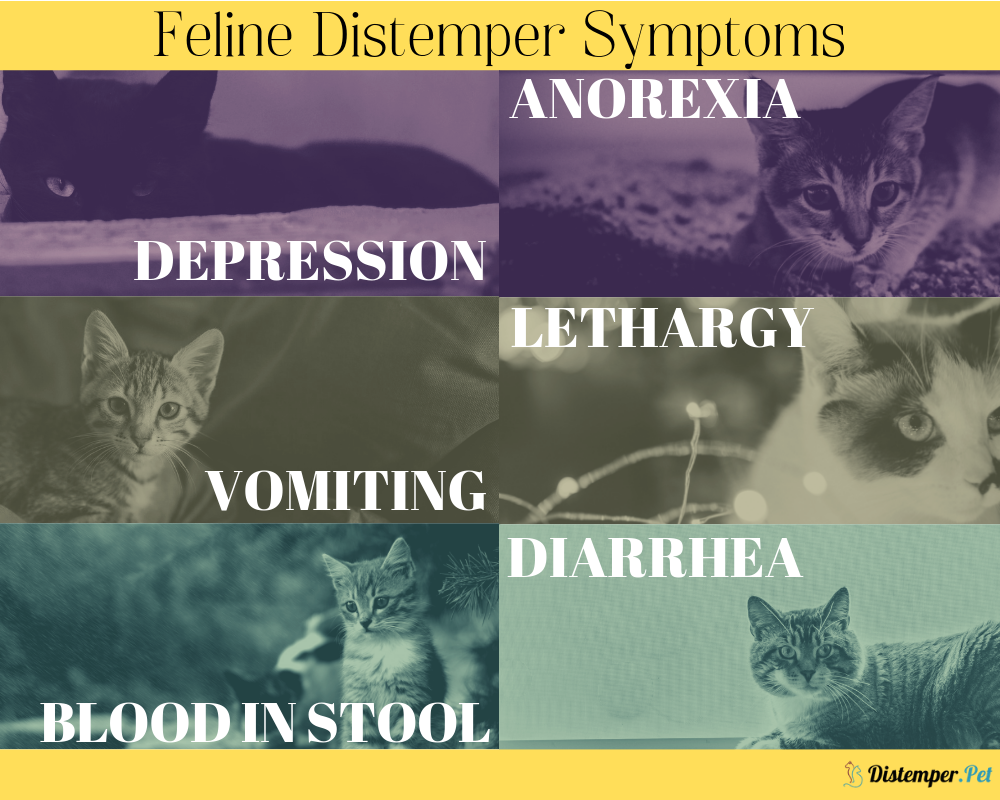Cat Distemper

Feline Distemper is an infectious viral disease closely associated with Canine Parvovirus that threatens the cat population. It is also commonly known as Feline Panleukopenia (FPV) as it affects and destroys the bone marrow and lymph nodes.
The virus also destroys cells in the intestinal wall, causing the loss of both white blood cells and red blood cells. As this virus attacks the blood cells, it can cause anemia, weakening the cat’s immune system and leaving their body wide open and vulnerable to other infections.
Moreover, Panleukopenia can affect cats of all ages. Pregnant cats, immune-compromised cats, kittens between 2-6 months, and unvaccinated ones have the highest risk of catching the virus. In contrast to Canine Distemper, this virus can survive in a dark, humid environment for up to one year.
In principle, all cats and kittens are at risk of developing the disease, so vaccines are possibly the best shield and protection against it.
Transmission
Contact with infected urine, saliva, feces, nasal secretions, blood, or even fleas from an infected cat causes Feline Distemper. The virus can be spread through shoes, clothing, bedding, and other items. Humans who had contact with an infected cat and did not wholly wash or disinfect their hands can also pass the virus to another cat.
The virus is highly resistant to almost all environmental conditions, making it difficult to destroy and eliminate. It also can remain infectious even after years have gone by. Routine household disinfectants are not enough to kill the virus. It is advisable to use 1 to 30 dilutions of bleach to clean surfaces.
Incubation Period
The incubation period is between the virus’s initial exposure to the virus and the start of symptoms. This period is determined by various factors, including the cat’s age, the severity of the disease, and the condition of their immune system. Feline Distemper can last about 5-7 days on average, though it can reach up to two weeks.
Signs and Symptoms
The clinical indications and signs of the virus are based on several factors, including the severity of the virus, potential breed predispositions, and the cat’s age. The virus’s early signs and symptoms are loss of appetite and lethargy, then rapid progression to severe, which consists of vomiting to bloody diarrhea.
You might observe that the symptoms for Feline Panleukopenia can be similar to those of other infections like Salmonella, which is why you need to bring them to the veterinarian as soon as they experience the symptoms.
A diagnosis of the Feline Distemper is presumed if diarrhea and vomiting are present alongside a low white blood count result. The diagnosis is confirmed if the virus is detected in feces or blood.


Symptoms usually appear about 4-6 days after the initial exposure. Although, they can occur at any time between 2 and 14 days.
Feline Distemper kills actively separating cells found in the intestines, tissues in the lymph nodes, and bone marrow. The virus assaults the gastrointestinal tract’s lining, causing ulcerations and the shedding of intestinal tissues.
Pregnant cats that are infected become exceptionally sick, which could bring harm to their kittens. There is a risk of abortion or giving birth to kittens with damage to the part of their brain that coordinates their muscles, bones, and nerves. Infection may also lead to stillbirth, fetal resorption (fetus disintegration in the uterus), or mummification.
Diagnosis
To accurately diagnose your cat, the veterinarian must look at their medical history and vaccination records. They will need to conduct a series of laboratory tests, such as urinalysis, complete blood count, and biochemistry profile, along with a physical examination. The blood cell loss is a significant indicator that the veterinarian will need to diagnose panleukopenia.
Going over the cat’s recent activities with the vet could also help. It determines whether the cat has recently come in contact with other felines or if they are allowed to go outdoors. Knowing these things can help point a veterinarian in the right direction.
Feline Distemper is often confused with different diseases as the symptoms are somewhat similar. Amongst those diseases are pancreatitis, feline leukemia, poisoning, and feline immunodeficiency virus. Giving the veterinarian all the necessary details would help the cat get the appropriate treatment to recover.
Complete Blood Cell Count
A complete blood count (CBC) is a laboratory test that indicates whether there is a low number of blood cells in a feline’s body or not. A low white blood count is a decent marker of the disease and may also indicate the early phases of anemia.
Different blood samples are taken a few weeks apart to decide whether the quantity of cells is increasing or decreasing.
ELISA Test
The ELISA test, short for Enzyme Linked Immunofluorescent Antibody Test, is utilized to detect and identify antibodies and other contagious microbes and pathogens in a sample.
Antibodies are made in a body as a direct response to infection, so the result of an ELISA test can tell if a feline has any recent contact with the virus. This test needs a fecal swab to recognize viral antigens and would typically require 10 to 15 minutes to run.
Fecal Sample
Contact your vet before your planned or scheduled appointment. Inquire as to whether you ought to get a sample of your pet’s stool.
If this is the case, use a bag or sack and gather a sample from their litter box. If this makes you uncomfortable, your vet can collect the sample they need during the appointment.
No tests can 100% accurately confirm Distemper in cats. Although, positive results in a cat that has symptoms are a good indicator of it.


False negatives are entirely possible even in an infected cat, and the results may vary depending on the test timing and sample quality. A cat with negative results should be tested again.
They should also be handled as if they are infectious to be extra safe. Know that results are most accurate when the cat is tested a few days after exposure or within 5 days after the symptoms appear.
Environmental Factors
Feline Distemper can last in the climate for as long as a year in dark, humid, and moist areas, unlike Canine Distemper, which can’t endure more than a couple of hours outside of the dog’s body.
The disease can likewise live on many surfaces as it is impervious to several surfaces. It also tends to be passed on through hands, feet, shoes, clothing, or materials like sheets, food bowls, and other pet equipment.
Top 5 Frequently Asked Questions
Feline Distemper, or Panleukopenia, is an exceedingly infectious and dangerous illness caused by a virus that attacks the bone marrow and lymph nodes. It is highly contagious and is spread through contact with an infected cat’s urine, saliva, blood, feces, or nasal discharge.
Cats and kittens are the likely victims of this virus. Your cat can pick it up from various places and surfaces that had contact with an infected cat.
Unlike Canine Distemper, which can only last for a couple of hours outside of its host, the virus can live and survive in the environment for up to a year.
Aside from picking this virus up through saliva, blood, urine, and nasal discharge, humans that had direct contact with an infected person and didn’t wash their hands could also pass this along.
The feline parvovirus is what causes the Distemper in cats. Cats acquire the parvovirus after coming into contact with contaminated feces, saliva, urine, or possibly fleas that bit an infected cat.
Thinking they are similar is an easy mistake to make. What most fur parents fail to realize is that they are different diseases with different viral agent causes.
Feline Distemper typically targets kittens, cats with weak immune systems, and pregnant felines. Canine Distemper, on the other hand, somewhat resembles measles in humans. This virus locks on young and unvaccinated puppies and older dogs with a much weaker immune system.
Signs and symptoms for Feline Distemper often show about 4-6 days after the initial exposure, though it could show up anytime between the 2- to 14-day period.
The symptoms of Feline Distemper can be similar to Salmonella, which is why it is vital to take them to a vet immediately once you start suspecting them of having the virus. It is to help contain the virus, limit its chances of spreading, and come up with the appropriate treatment plan.
Other Frequently Asked Questions
The most common way of transferring the Feline Panleukopenia Virus is through direct contact with an infected cat. It can also be passed on by humans if they do not wash their hands thoroughly enough. Passing them through contaminated clothing, bedding, or shoes is also possible.




